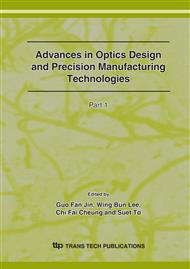p.980
p.986
p.992
p.998
p.1003
p.1009
p.1015
p.1021
p.1026
A Quasi-Steady-State Thermal Model for Laser-Assisted Cutting of Zirconia Ceramics
Abstract:
This study has developed a thermal model for laser-assisted cutting of zirconia ceramics. Laser-assisted cutting can increase ceramics removal rates by utilizing a localized heat source to elevate the workpiece temperature prior to material removal with traditional cutting tool. At high temperatures the yield strength of ceramics can decrease below the fracture strength, changing the material deformation behavior from brittle to ductile and enabling the use of a single point cutting tool to remove material at rates approaching those of metal cutting. A thermal model has been developed for the workpiece of ceramics cylinder rotating with a constant speed, which was preheated by a laser and cut by cutting tool. Since the cutting tool followed the moving laser with a fixed distance in the axial direction, i.e. the feed rate of the cutting tool was the same as the moving velocity of the laser, this thermal model has been formulated in a cylindrical coordinate system that moved with the laser beam or cutting tool and therefore, this problem was a quasi-steady-state problem. An analytical solution for this thermal model has been obtained. The results calculated by this model agree with the available experimental data. The temperature field is presented during laser-assisted cutting of ceramics. The effects of feed rate and laser power on temperature field are also discussed in this study.
Info:
Periodical:
Pages:
1003-1008
Citation:
Online since:
December 2007
Authors:
Price:
Сopyright:
© 2008 Trans Tech Publications Ltd. All Rights Reserved
Share:
Citation:


